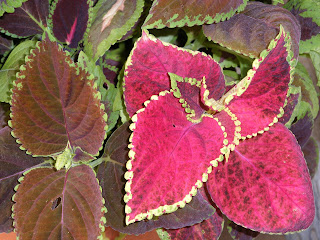There is no such thing as a "typical" year or, even less realistically, "typical" weather. This simple idea is being borne out in the garden here at the height of summer, which at times hasn't been very summery at all (although we are now enjoying low 80s, low humidity, and blue skies).
For example, Canadian columbines (
Aquilegia canadensis) should be long gone at this point, yet here are some new blooms:

(Sorry for the blurriness)
Another oddity is my Joe-Pye weed (
Eupatorium maculatum), which should have started blooming at least a week ago but is just now starting to blossom.

(A closer look at an emergent bloom from another angle)

That is the Salvia 'Plumosa' below the Joe-Pye weed. It's still going strong and maintaining my salvia puddle, although it's starting to look tired, if you ask me. (And yes those are stakes you see. I admit it--I stake these salvias.)

In more, well, typical developments, my astilbe is blooming steadily if not grandly. After its near-death experience last year, I'm just happy to have it blooming at all.

I like the astilbe next to the Japanese painted fern (
Athyrium niponicum) because of the symmetry of their shapes and the pink panicles next to the frosty green and purple foliage.

(The plants look nice; too bad all around them is mulch-less ugly barrenness.)
This big-leaved aster (
Eurybia macrophylla) is the only one blooming out of the four I planted this spring, but I'm not complaining about that ratio.

Seeing as this is the "sleep" year out of the "sleep, creep, leap" cycle, I'm pleased to have any blooms. Although in this picture the flower looks white, in person it's a very pale shade of lavender, a nice surprise.
I've given up on trying to remove the flowers of my cilantro plants to maintain vigorous foliage growth. I've just been too busy and they're too prolific, so now I'm hoping for some reseeding. They make an interesting, lacy little understory to the columbine foliage.

And how could the July garden be complete without at least one daylily? Right now one is all I have blooming:

(Anyone recognize this cultivar? It was here when I got here.)
Here is the same daylily next to a spent spirea, which had baby pink flowers when it bloomed. That's right--light pink flowers next to bright yellow and orange flowers. Offensive to the eyes, even just in your imagination!

For those of you who won books through
Elizabeth's crazy color combo contest on
Garden Rant, you should be glad that these weren't in bloom at that time. I would have been a runaway winner. Seriously, what was I thinking when I put those spireas there??
And although these aren't technically blooms, I have some darling little bell peppers growing that I wanted to display.

(Almost too cute to eat, but not quite.)
Happy bloom day to all! For more see
Carol at May Dreams Garden!







































